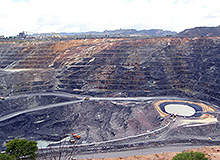
Top 5 Countries with the Biggest Uranium Reserves
Australia
Australia, the world’s biggest uranium reserve holder, was estimated to possess 1.66 million tonnes (Mt) of known recoverable uranium resources as of 2011, accounting for about 31% of the world total. The nation produced 7,488t of uranium in 2013, becoming the third biggest uranium producing country.
Australia began uranium mining in 1954 and currently has four active mines, including the world’s second and third biggest uranium producing mines, respectively Olympic Dam in the Northern Territory and the Ranger mine in Southern Australia. The other two mines Beverley and Honeymoon, both located in South Australia, commenced production in 2000 and 2011 respectively.
Honeymoon mine, operated by Uranium One, was however closed in November 2013 but will be maintained as owner Uranium One waits for an improvement in uranium prices.
Owned by BHP Billiton, Olympic Dam contains 358,530t of uranium reserves is the country’s biggest uranium mine followed by the yet to be developed Jabiluka uranium deposit, which is estimated to contain 67,700t of uranium reserves. Four Mile, Kintyre, Valhalla, Yeelirrie, and Wiluna are among the other major uranium deposits yet to be developed.

Kazakhstan
Kazakhstan, the world’s second biggest uranium rich country, held 629,100t of known recoverable uranium resources as of 2011, accounting for 12% of the world’s total uranium resources. The country has been the biggest uranium producing country since 2009 and in 2013 output stood at 22,500t, 38% of the world’s total uranium production during that year.
Kazakhstan has 50 known uranium deposits in six provinces, and more than 20 operating uranium mines. The Chu-Sarysu basin in central Kazakhstan alone accounts for over half of the country’s known uranium resources, while the Syrdarya basin in Southern Kazakhstan and the Akmola region in Northern Kazakhstan also possess significant uranium resources. State-owned Kazatomprom controls all uranium exploration and mining activities in the country through its subsidiaries or joint ventures with foreign companies.
The Tortkuduk uranium mine located on the Chu-Sarysu basin, owned and operated by KATCO (a joint venture between AREVA and Kazatomprom), produced 2,661t of uranium in 2012 becoming the biggest uranium producing mine in Kazakhstan and the world’s fifth biggest uranium producer. Kazakhstan also hosts the world’s seventh biggest uranium producing mine Budenovskoye 2, which is owned and operated by Karatau (a joint venture between Kazatomprom and Uranium One) and the tenth biggest uranium mine South Inkai, which is owned and operated by Betpak Dala, another joint venture between Uranium One and Kazatomprom.
Russia
With 487,200t of known recoverable uranium resources by 2011 estimates, Russia is the world’s third richest uranium country. The country produced 3,135t of uranium in 2013 becoming the sixth biggest uranium producing country after Kazakhstan, Canada, Australia, Niger, and Namibia.
Most of Russia’s uranium deposits are located in four districts including the Trans-Ural district in the Kurgan region, the Streltsovskiy district in the Chita region of south eastern Siberia, the Vitimsky district in Buryatia region, and the Elkon district in the Yakutia region.
AtomRedMetZoloto (ARMZ), a mining arm of Russia’s state-run nuclear corporation Rosatom, takes care of all uranium mining and exploration activities in the country. Streltsovskiy is currently the principal uranium producing district in Russia with modest production coming from the Trans-Ural and Vitimsky districts.
The Kraznokamensk underground mine, located in the Chita / Transbaikal region and operated by Priargunsky, a subsidiary of ARMZ, produced 2,011t of uranium in 2012 becoming the biggest uranium mining operation of Russia and the eighth largest in the world.

Canada
Recoverable uranium resources estimated to be 468,700t as of 2011 make Canada the world’s fourth biggest uranium holder, accounting for about nine percent of the world total. Canada produced 9,331t of uranium in 2013 becoming the world’s second biggest uranium producing country.
Canada’s uranium resources are mostly concentrated in the Saskatchewan province. McArthur River and Rabbit Lake were the only two uranium producing mines in the country as of early 2014; uranium production is however anticipated to increase significantly in near future with a number of new mines currently under construction or in planning stage.
The McArthur River mine operated by Cameco produced 7,744t of uranium in 2013 making it the world’s biggest uranium producing mine. The, mine which has been in production since 1999, is estimated to contain 148,300t of uranium in proven and probable reserves.
Cigar Lake mine, also owned by Cameco, contains 83,560t of uranium in proven and probable reserves and is scheduled to commence full production in 2017. Areva’s Midwest mine and Cameco’s Dawn Lake and Millenium mines are among the other notable uranium mines in Canada.

Niger
Niger’s 421,000t of known recoverable uranium resources as of 2011 make it the world’s fifth richest uranium country, while it was also the world’s fourth biggest uranium country with 4,667t of production in 2012.
Uranium mining operations in Niger are mostly concentrated around the twin mining towns of Arlit and Akokan, while most of the country’s uranium output is from the Société des Mines de l’Air (SOMAIR) and Compagnie Miniere d’Akouta (COMINAK) joint venture mining operations led by Areva.
The Societe des Mines d’Azelik (SOMINA), majorly owned by China Nuclear International Uranium Corporation (SinoU), started production from the Azelik/Teguidda uranium deposit located 160km south-west of Arlit at the end of 2010.
SOMAIR’s Arlit mine produced 3,065t of uranium in 2012 becoming the world’s fourth biggest uranium producing mine. Africa’s biggest known uranium deposit Imouraren, located 80km south of Arlit which has been developed by a majority-owned Areva subsidiary since 2009, will be a major uranium mining operation in Niger when it commences production in 2015.




